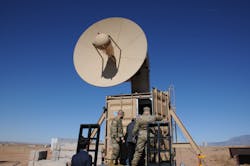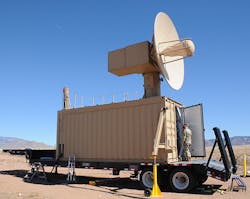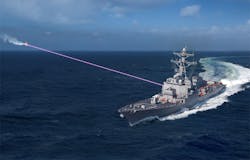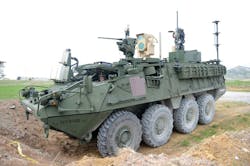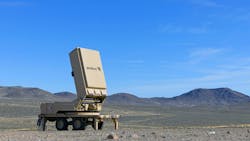An upward trajectory for directed-energy weapons
By Jim Romeo
Directed-energy weapons are electromagnetic systems that convert chemical or electrical energy to radiated energy. They are focused on target and on physical damage that degrades, neutralizes, defeats, or destroys an adversarial capability. Directed-energy weapons include systems that use high-energy lasers that emit photons, and high-power microwaves that release high-power radio frequency waves.
High-power microwave weapons create beams of electromagnetic energy over a broad spectrum of radio and microwave frequencies intended to couple and interact with electronics located at a target and then causing damage or temporary disruption.
"There's no direct definition for what's the difference between a high-power microwave directed-energy weapon and a radar, but we've tempted to basically have a dividing point of that," says John Tatum in a webinar, sponsored by the Defense Systems Information Analysis Center in 2019 [https://dsiac.org/webinars/high-power-radio-frequency-microwave-directed-energy-weapon-effects/]. " If a source has a peak effective radiated power of greater than 100 megawatts or radiated energy of greater than one joule per second, it typically will fall into the area of high-power microwave sources."
As Tatum explains, the range of frequencies of these radiation sources can vary significantly on the electromagnetic spectrum of high frequency to very high frequency to ultra-high frequency to microwaves to millimeter waves.
"The most important thing to remember about high-power microwave and directed-energy weapons is that they can attack targets with and without intentional antennas and receivers," Tatum explains. "That's unlike traditional electronic warfare jammers. They also can produce persistent effects that last much longer than the time the team is on the target. As a result, they can produce temporary electronic upset or significant energy damage. As a result of this, we have an unconventional electronic attack. "
Ongoing development
Prototype development for directed-energy weaponS has been ongoing in the U.S. Air Force, Army, and Navy. The Office of the Secretary of Defense (OSD)The Air Force Research Laboratory Directed-Energy Directorate at Kirtland Air Force Base, N.M., has been working on two non-lethal high-power electromagnetic weapons — the Active Denial System (ADS) and the Counter-electronics High Powered Microwave Advanced Missile Project (CHAMP).
ADS is a low average power microwave system designed to penetrate the skin to a depth of 1/64 of an inch — about the thickness of three sheets of paper. It has been compared to feeling the blast of heat that comes from opening a hot oven; extensive testing has shown it to have no damaging effect on human skin or organs. Used against ground forces or armed mobs, it would force them to disburse and retreat.
CHAMP uses high-peak-power microwaves lasting less than half the time it takes to blink — too brief to harm human beings but more than enough to disable or destroy electronic circuitry. A CHAMP system mounted in a UAV could fly over an enemy-held city and surgically destroy enemy command, control and communications systems — even hitting one building, skipping the next, then hitting a second — without damaging any critical civilian systems or harming anyone in the target area. Damage to enemy capabilities would be at least as great as a direct strike with a bomb, but with no structural or collateral damage.
Air Force Research Laboratory-Kirtland demonstrated a mobile tactical high-power microwave operational responder (THOR), with an aggressive agenda to reach warfighters soon. The intent of THOR is to be up and running in three hours by two people. It's designed to take down several enemy unmanned aerial vehicles (UAVs) simultaneously with rotational antenna control to provide 360-degree coverage, with the firing mechanism and overall systems control, coming from a laptop computer.
Since 2019 the Army Space and Missile Defense Command at Redstone Arsenal, Ala., set out to develop four 50-kilowatt Multi-Mission High Energy Laser (MMhigh-energy laser) Stryker-mounted weapons. Those would be 10 times more powerful than an artillery system soldier have been testing in Germany since 2018. Part of the Army’s Maneuver-Short Range Air Defense (M-SHORAD), MMhigh-energy laser would protect mobile Brigade Combat Teams from unmanned aerial systems, rotary-wing aircraft and rockets, artillery and mortar (RAM).
Vehicle-mounted laser weapons
The Army is also developing a 100-kilowatt-class High Energy Tactical Vehicle Demonstrator (high-energy laser-TVD) prototype laser system for Medium Tactical Vehicles. The Army's work will serve as a research component for other directed energy weapons across the military services.
Aboard the guided missile destroyer USS Preble (DDG 88), this high-energy laser uses an integrated optical dazzler and surveillance unit (high-energy laserIOS). It is a 60-plus kilowatt laser and is designated Increment 1 of the Surface Navy Laser Weapon System (SNLWS) program. [https://www.militaryaerospace.com/sensors/article/14289209/shipboard-electronics-unmanned-hypersonic]
Lockheed Martin referred to the high-energy laserIOS as an “endless magazine that never runs out of bullets.” It's able to destroy surface and airborne threats and dazzle or blind optical sensors aboard hostile ships and aircraft, and optical seekers of anti-ship missiles.
According to a September 13, 2022, report [https://crsreports.congress.gov/product/pdf/R/R46925] "Department of Defense Directed Energy Weapons: Background and Issues for Congress," prepared by the Congressional Research Service summarized budget allocations, the OSD is prepared to allocate generous program funding outlays to develop these weapons systems. The report states:
"In FY2023, OSD requested $16 million for High Energy Laser Research Initiatives, including basic research and educational grants, and $49 million for High Energy Laser Development, which funds applied research. 19 OSD additionally requested $111 million in FY2023 for High Energy Laser Advanced Development, which is focused on 'scaling the output power of DE systems to reach operationally effective power levels applicable to broad mission areas across the DOD.”
Also in the report, OSD also requested $11 million in FY2023 to continue ongoing assessments of directed energy weapons, including assessments of the weapons’ effects, effectiveness, and limitations. In addition, DARPA’s Waveform Agile Radiofrequency Directed Energy (WARDEN) program seeks to “extend the range and lethality of high-power microwave weapons ... [for] counter-unmanned aerial systems, vehicle and vessel disruption, electronic strike, and guided missile defense.”
Strategic focus on directed-energy weapons
"One of the most crucial strategic needs in today’s cutting-edge RF and microwave weaponry is test, design, and measurement." says John S Hansen, aerospace"These types of higher energy weapon systems require a very tight matching of system elements to ensure maximum power is coupled to the antenna, which additionally requires rigorous calibration and maintenance processes. It is very important to design, test, and measure electric and electronic systems with the most advanced instrumentation and modeling software tools in the development and calibration stage of such energy systems. For example, Electronic Design Automation (EDA) software design tools can be applied or adapted to facilitate the modeling and development process of amplifiers and antennas including beam shape and steering. Test instruments can be used to investigate such things as the temporal characteristics of pulses or other waveform properties at a low power level," says John S Hansen, Aerospace & Defense Strategic Planning for Keysight Technologies.
James Marceau is a managing director with Alvarez & Marsal’s private equity performance improvement group. He has been a trusted expert at the highest levels of the U.S. Department of Defense (DoD) and all branches of the military, Homeland Security and foreign governments where advises aerospace and defense (A&D) OEMs, prime contractors and others in the defense industrial base.
Marceau emphasizes that the development of electromagnetic and high-energy RF and microwave weapons is a significant field of research for the aerospace and defense industry, and militaries are showing substantial interest in this field globally.
"Directed-energy weapons have been deployed primarily as a force multiplier, able to damage physical targets with greater precision and accuracy, resulting in a competitive advantage over traditional weapons. Especially given the current heightened global threat landscape in Europe and Asia, militaries are seeking any potential advantages," he says. "There have also been increased efforts to develop Air Defense suppression systems that use airborne lasers to disrupt or disable an opponent’s own defensive weapons."
Defensive laser weapons
Marceau says that growth in this market is driven by investment from branches of the Air Force, other Defense agencies, and the private sector companies who are eager to test the strength and effectiveness of directed-energy weapons. "Examples of current and prior developments include High Energy Laser (high-Dr. David Stoudt is a senior executive advisor at Booz Allen Hamilton in Maryland. Stoudt provides leadership and guidance on the science and business of advancing directed energy capabilities for American warfighters. He previously spent 32 years serving in the Department of Navy, 12 of them as the Navy’s first distinguished engineer for directed energy, an executive position and helped lead the establishment of world-class directed energy programs and facilities at the Naval Surface Warfare Center in Dahlgren, Virginia (NSWCDD).
"A key trend right now is the imperative to reduce size, weight, power, and cooling (SWaP-C) requirements in order to make these weapons viable for operational deployment," says Stoudt. "There is an ongoing challenge of directed energy weapon systems being too heavy, too large, too under-powered, and too expensive for widespread deployment.
In the modern battlespace, we must balance the need for power with the need for mobility. Now, with the development of fiber lasers, electromagnetic and high-energy weapons can take a more meaningful role in the DOD arsenal. By using modular open-system architectures and optimizing SWaP-C, military and operational utility is enhanced to bring directed energy where it previously couldn’t be integrated into warfighting platforms."
Stoudt emphasizes that direct energy systems are developed with a definite intent to play a role in defeating unmanned aerial systems. "The primary use case and key differentiator right now is using directed energy systems to defeat Unmanned Aerial Systems (UAS)," he says. "Epirus? next-generation family of Leonidas systems utilize solid-state software-defined high-power microwave to achieve significant counter-electronics effects against UAS targets. Leonidas utilizes software-defined Active Electronically Scanned Array (AESA) with AI-enabled power management schemes to drive dozens of solid-state repetitively pulsed GaN tunable narrowband power amplifiers. This allows for a rapidly tailorable narrowband waveform to enhance effectiveness. The SPEAR (Specialized Portable Electromagnetic Attack Radiator) system is an ultra-wideband, portable, compact, and high-power electromagnetic source that can also be used against individual and swarm drone threats. Due to its portable size, low weight, low power requirements, and efficiency, SPEAR provides Counter small Unmanned Aircraft System (C-sUAS) capabilities to ground vehicles, fixed platforms, and field troops. The SPEAR application contributes critical niche advantages to a layered defense approach, which is foundational to achieving overmatch and defeating threats. It's important to note that directed energy is a uniquely versatile technology family, with several subsets that can be tailored to different applications."
Electromagnetic weapons
Electromagnetic and high-energy RF and microwave weapons are crucial in how they both serve to improve warfare capabilities and new innovation. The use of electromagnetic pulses is a significant capability that stands to be a notable differentiation in this technology and the future of this class of weaponry.
"The ability to control and direct high-power microwave weapons is what makes them so effective and valuable to the development of warfare capabilities," note James Marceau. "Electromagnetic pulses (EPM) can disable electronics within a large radius, and when these energy bursts are concentrated, they canDr. Stoudt points out that the number of potential applications for DE systems is growing every day, which is largely explained by the versatility of the technology behind the weaponry.
“This is due to the flexibility of the DE spectrum, but also the reality that kinetic solutions are either not sufficient or cost-effective to bring to bear against a wide range of threats and in a number of operational scenarios,” explains Stoudt. “The convergence of the operational need to combat these threats with the rapidly increasing maturity of directed energy technology is greatly increasing the demand for fieldable weapon systems. The country that develops and fields this technology at scale first will have a distinct advantage over their adversaries.”
There are numerous examples that illustrate the value of how directed energy weapons can have great utility.
Stoudt says that the ongoing Ukraine-Russia war is an example of the future of warfare in which urban combat among large civilian populations and the use of unmanned aerial vehicles is the norm.
“Whether you call them electromagnetic, high-power RF, or high-powered microwave (high-power microwave) weapons, they can be used to neutralize enemy capabilities and combatants nonlethally and, in many cases, avoid material damage or civilian casualties,” explains Stoudt. “Beyond this, the systems offer a wide-range of benefits including deep magazine capacity, a more simplified resupply logistics strategy, low cost per shot, speed-of-light engagement, and extreme accuracy.”
Non-lethal weapons
Stoudt adds that there are a number of examples of this type of weapon on the market, including the Epirus’ family of Leonidas systems, and the SPEAR which utilizes high-power radio frequency to achieve counter-electronics effects against UAS targets.
"Additionally, THOR (Tactical High-Power Operational Responder) is a very high peak power counter-swarm electromagnetic weapon developed by the Air Force Research Laboratory that is used to disable aerial drones, especially drone swarms," says Stoudt. "Looking ahead, we will continue to see the development of high-power radio frequency systems that bring the newest technology to bear against the growing threat of unmanned aerial vehicles, as well as other adversary capabilities.
"directed-energy weapons are likely going to reach sophistication and full maturity within the next ten years, so the development of electromagnetic and high-energy RF weapons is expected to continue," says James Marceau. "Increasing air threats, such as hypersonic missiles, create another need for directed-energy weapons as a potential deterrence method, and I expect this to be explored further in the coming years. Lastly, the Aerospace & Defense industry is not immune to rapid advancements in artificial intelligence (AI). We may see electromagnetic weaponry integrated with AI and autonomous systems to increase effectiveness. This could provide opportunities for new players to contribute their expertise outside of the traditional OEMs and mid-tier suppliers. However, directed-energy weapons still face several obstacles that will need to be investigated: high levels of power supply are needed, they must be durable and accurate in rough weather conditions, and High Energy Laser (high-energy laser) systems need cooling solutions to maintain constant temperatures."
Marceau says that his Aerospace, Defense, Aviation and Space team at Alvarez & Marsal regularly helps our corporate and private equity clients identify R&D and go-to-market opportunities and strategies for emerging technologies, such as directed-energy weapons. "This technology is critical for national security, and the evolving global threat landscape has increased demand and public and private investment in companies focusing in this area," he says. "As these capabilities mature and advance in technology readiness level (TRL) and into production, manufacturers of these weapons and suppliers will likely need to navigate high demand signals, supply chain disruption and raw material availability, inflation cost increases, operational issues during scale-up, and competition for top technical talent."
The future of directed-energy technology
The importance and visibility of directed energy weapons is at the forefront of how many of the services are approaching further development of directed energy technology.
The U.S. Navy, for example, is reorganizing its key warfare center that develops many related programs and prototypes of this weapons category. Recently, Naval Surface Warfare Center Dahlgren Division (NSWCDD) reorganized part of their workforce to include the Integrated Engagement Systems Department, leadership looked at the two different directed energy weapons categories of high-energy laser and high-power microwave (high-power microwave) weapon systems. These areas historically maintained in a single division. They have reorganized and split them into respective divisions, recognizing the need for continued growth and development in both areas that have similar technical roots. They acknowledge that the impetus behind the warfare centers reorganization is in response to a growing demand from the operational community for novel DE weapon systems resulted in a corresponding growth in NSWCDD’s technical capability in this area.
At The Air Force Research Laboratory (AFRL) recently opened a new High-Power Electromagnetic Effects and Modeling Facility at Kirtland AFB. The new $6 million facility supports high-powered radio frequency weapons systems and contains a dedicated forensic lab for studying a range of HPEM targets after engagement. The new facility will allow for greater collaboration as the Air Force is set to advance directed energy technologies.
Other agencies are also expanding their research and programs as well. There seems to be strong consensus and widespread support in Congressional committee for programmatic funding for the past couple of years now, and this will likely last long into the future.
The House Armed Services Committee in their "Future of Defense Task Force 2020" [https://moulton.house.gov/imo/media/doc/FODTF%20Report.pdf]identified direct energy weapons as emergent technologies in defense that Congress must be aware and vigilant. This may have set the stage for the opportunity to further develop directed energy weapons technology in the years ahead.
In their report they justifiably listed, along with many technologies, directed energy weapons, giving good reason to believe that funding and support for research and development of directed-energy weapons is robust. The gravitas of this weaponry is characterized in the report’s prologue to the listing of concerning technologies, indicating it is a priority:
"A sophisticated array of new weaponry [directed energy weapons] is changing the nature of conflict, and, while most of the technologies will require substantial funding and development by state actors."
